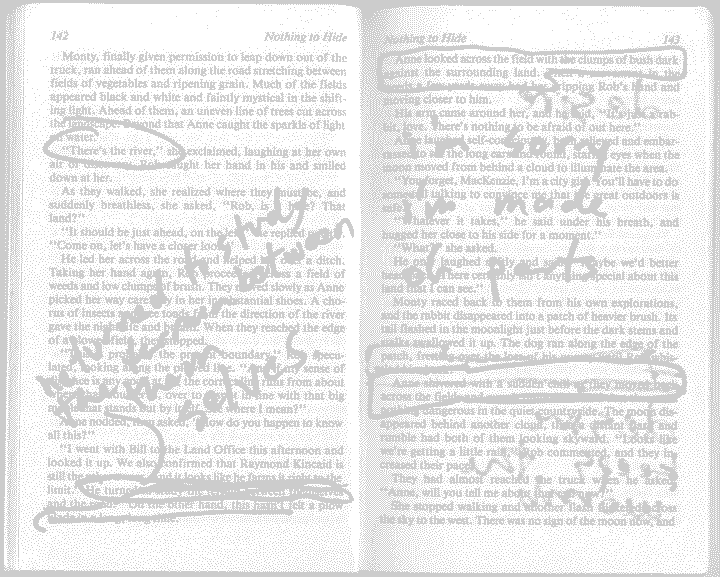Found this trashy romance novel at the el stop. Was going to use it as
a notebook, but when I opened it, decided it would be much more
interesting if the text that was already there served as more than
some artsy background. What if, instead, a sort of intercourse could
occur that would redefine both the textual background and the textual
foreground?
So I took my fat black magic marker and started marking stuff out;
underlining and circling words, sentences, paragraphs; reconnecting
and inserting text between and on top of and underneath; selecting and
editing; repeating words, phrases, images; subverting; exposing;
re-inventing; (re)creating….
I write about things I would never write about; I say things I would
never say; I tackle languages and meanings I would never touch. And
while I am within it, navigating through it, producing and not
producing it, I’m really not worried about whose it is or where the
line of authorship is. There is no limit, as there is a certain
dissociation, a certain non-authorship, a certain suspension of self
and other. A new life is created which can never be mine, and can
never be theirs. The creation doubles over, speaking of its own
interactions. The meaning brought out, skimmed and produced, subverts
and doubles, constructs and de-constructs the original text. The
original no longer exists without its mutated double, its child.
Landscapes become explicit. Frictions are mined. The horizontal plane
constructed between is encircling, enabling – as sometimes I am below,
sometimes above. Sometimes following the wind, sometimes the sea, but
always it is an interaction, a navigation, of the immediate as
opportunity, not possibility. While afterwards, in reading the new
production from outside the plane, the plane seems to be only a new
construction, a new production, a new line cut between self and other,
while within it, the plane is non-separated; the production and
process redefine themselves; the self and other are continually
reinvented. The path, the construction, is navigated through
intuition on a semi-and-sub-conscious level – as the self-construction
is the product, the interaction, the vertical of the forces. The self
is not transcendent, but a simultaneous product and production, not
fully conscious because never aware or directing all force, only
navigating. The consciousness continually redefined by its self.
Sometimes I take the plane and turn it against its self, attempt to
reconcile the lost self, attempt to form a concrete and absolute logic
of self/other, attempt to cut the present with images of the past. The
cutting edge becomes the plane turned vertically opposing its self,
redefining its self, re-creating its self through contractions of
belief. And there is a definite blindness to this sort of creation:
the contraction of belief is blind to its own production of the plane
of truths – truths that redefine and reconcile, separate and connect;
truths that even turn against the belief that creates them, forsaken.
Sometimes I operate conscious of my blindness. While within the plane,
while within the process, there is no outside, no form or space, no
self or other, no binary, except for the one (re)created – a cutting
edge of immediate fluidity that coagulates to a plane of static form
and structure (belief) only in the past. For at the cutting edge there
are only forces. I follow and find, navigate between. There is only
continual (re)creation, operating intuitively and immediately while
within it. The vertical frictionpiece redefines the horizontal
plane. Looking behind, I see a wake of redistributed truths. Looking
forward, there is only snow-blind and immediate (re)creation. Belief
re-creates blindly. Faith is the inherent blindness of
(re)creation. Creation is that blind instant where the self goes
beyond the self.
The inhabitation of the process of creation, the act of creation, is
what I dare to call art, what I dare to call life. The products are
only the remnants. The adult artist is an artist of product – she
quits her production at the climax of ambiguity, interest, and
possibility, in order to leave the product pregnant with
viewer-actuated (commodifiable) potential. The child artist is an
artist of process – she quits production when the process has ceased
to interest, when the vector has ran out, when the vehicle must be
abandoned as it no longer transports. The artist of death creates a
prepared vehicle, a kinetic coaster rolled to the top for the viewer
to enter. But the artist of life does not inhabit nor construct the
technical utopias of programmed possibilities, the pre-constructed
spaces of empowerment. For empowerment is always the false and
inverted image of power, the hologram by which power perpetuates
itself.
It is the artist of life who takes the vehicle not as the inverse
promise of the (absent) possibility of utopia, but as the immediate
tool that can break the very limits it was built to construct. The
text escapes the possible meanings given, the possible worlds
provided, through an opening, a creation, which is and is not its own.
